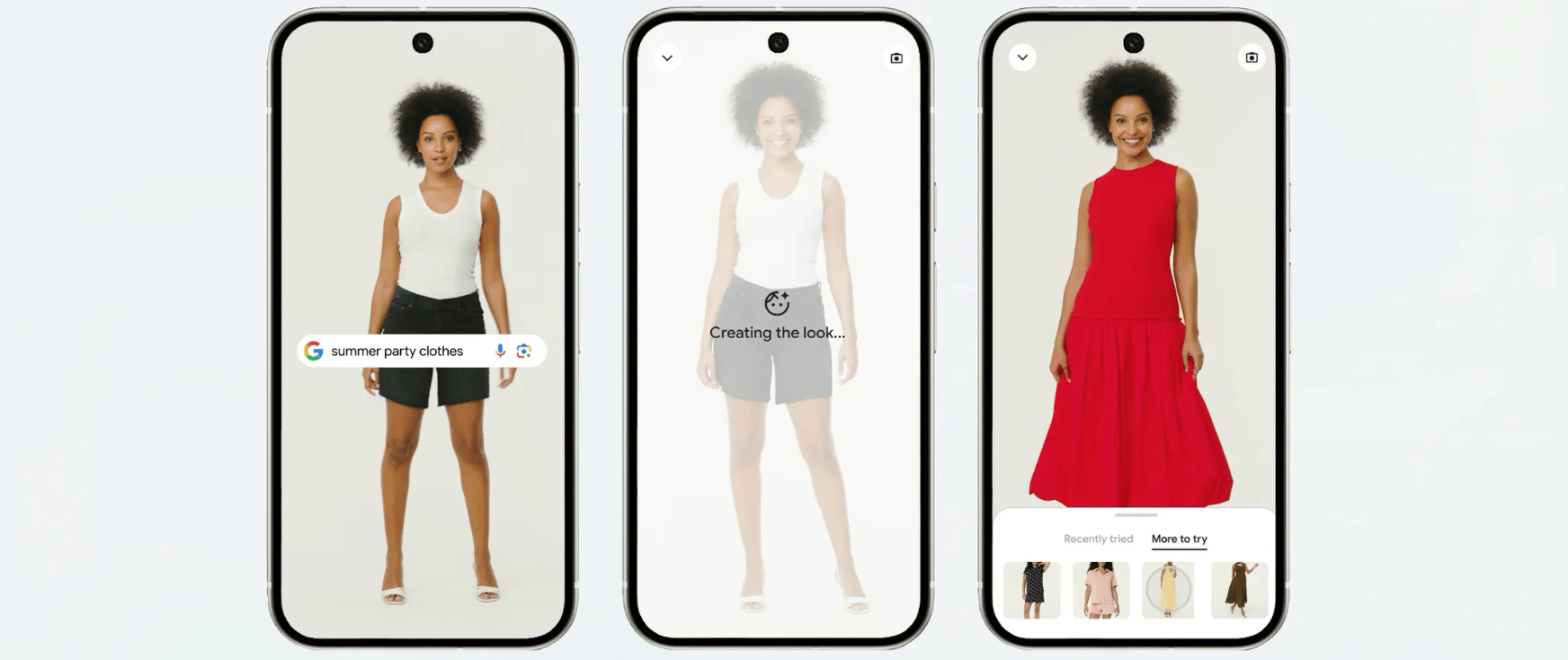- FryAI
- Posts
- Virtually try on clothes...
Virtually try on clothes...

The fryer’s hot, the feed’s alive, and you’re one scroll away from being the smartest one in the group chat. Let’s fry! 🍟
🤯 MYSTERY AI LINK 🤯
(The mystery link can lead to ANYTHING AI-related: tools, memes, articles, videos, and more…)
Today’s Menu
Appetizer: Google launches virtual fitting rooms 👕
Entrée: Scientists use AI to create cancer-fighting “GPS” 🩺
Dessert: Why are these bees wearing tiny QR codes? 🐝
🔨 AI TOOLS OF THE DAY
📖 Storyboard Generator: Create storyboards from scripts. → Check it out
🤣 JokrBar: Keep people engaged on your website with timely jokes. → Check it out
GOOGLE LAUNCHES VIRTUAL FITTING ROOMS 👕
What’s up? Google has officially launched its virtual “try on” feature, allowing shoppers to upload a full-length photo and see how clothes might look on them using AI.
How does it work? All you have to do is tap “try it on” when browsing apparel across Google Search, Shopping, or Google Images. After uploading an image of yourself, you’ll see what you might look like in that outfit! You can also set customized price alerts—specifying your ideal size, color, and budget—and Google will notify you when a match pops up.
Why should you care? These tools aim to save time and money while making online shopping more personal and fun. Whether you're buying school clothes, redecorating your room, or just browsing, Google’s AI makes it easier to discover what fits your style and wallet.
SCIENTISTS USE AI TO CREATE CANCER-FIGHTING “GPS” 🩺
What’s up? Scientists have used AI to create a molecular “GPS” that helps immune cells find and destroy cancer.
How does it work? The breakthrough involves custom-designed proteins that are added to T cells—our body’s natural cancer fighters—to help them locate tumors more precisely. Using three different AI models, researchers generated thousands of potential protein designs, then tested the most promising ones in the lab. One design stood out: when placed on T cells, it enabled them to seek out and kill melanoma cancer cells effectively. The work draws from the same AI-driven protein design methods that earned a Nobel Prize in Chemistry in 2024.
Why is this significant? This is early-stage research, but the implications are huge. Traditional methods for finding cancer-targeting proteins are slow and often unsuccessful. With AI, scientists can now rapidly engineer new tools that may one day lead to faster, personalized cancer treatments—and possibly even new therapies for other diseases.
WHY ARE THESE BEES WEARING TINY QR CODES? 🐝
What’s up? Scientists are placing tiny QR codes on bees to better track their behavior and uncover why their numbers are declining.
How does this work? Using AI-powered cameras and button-sized QR tags, researchers from the University of Oregon and Oregon State University are tracking hundreds of bees on a cannabis farm. Each bee is photographed in a “bee photobooth” and tagged with a unique code using non-toxic glue. Cameras trained to recognize bee species then scan the tagged insects as they fly by, helping researchers gather detailed data without hours of manual tracking.
Why is this important? Bee populations are shrinking at alarming rates, threatening global food systems that depend on pollination. This project blends technology and ecology to understand bee behavior and health at scale. By learning more about what’s harming bees, scientists hope to design better strategies to protect them—and the vital crops they support.
"I love bees–they’re just so lovely and adorable, and I love watching them visit flowers and all of their infinite variety and beauty and diversity. I love being part of something that will hopefully help, in the long term, bolster our agricultural system."
HAS AI REACHED SINGULARITY? CHECK OUT THE FRY METER BELOW:
Former Zillow exec targets $1.3T market
The wealthiest companies tend to target the biggest markets. For example, NVIDIA skyrocketed nearly 200% higher in the last year with the $214B AI market’s tailwind.
That’s why investors are so excited about Pacaso.
Created by a former Zillow exec, Pacaso brings co-ownership to a $1.3 trillion real estate market. And by handing keys to 2,000+ happy homeowners, they’ve made $110M+ in gross profit to date. They even reserved the Nasdaq ticker PCSO.
No wonder the same VCs behind Uber, Venmo, and eBay also invested in Pacaso. And for just $2.90/share, you can join them as an early-stage Pacaso investor today.
Paid advertisement for Pacaso’s Regulation A offering. Read the offering circular at invest.pacaso.com. Reserving a ticker symbol is not a guarantee that the company will go public. Listing on the NASDAQ is subject to approvals.
What do ya think of this latest newsletter? |
Your feedback on these daily polls helps us keep the newsletter fresh—so keep it coming!





